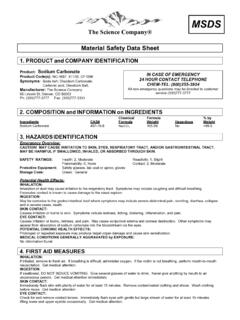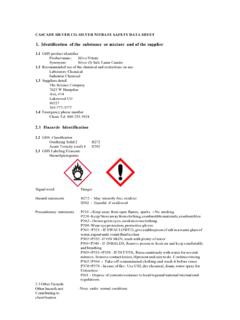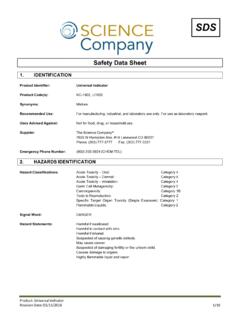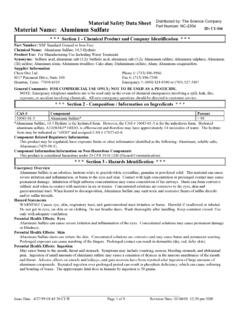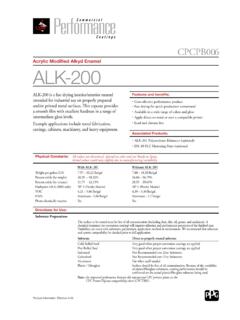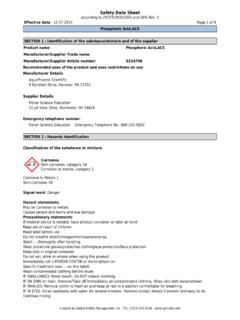Transcription of Safety Data Sheet - Science Company
1 Product: sodium hydroxide Revision Date: 05/19/2016 1/7 Product Identifier: sodium hydroxide Product Code(s): NC-0874, NC-2091, S1013, S1101, CF1131 Synonyms: Caustic Soda; Soda Lye; White Caustic. Recommended Use: For manufacturing, industrial, and laboratory use only. Uses Advised Against: Not for household use. Supplier: The Science Company 7625 W Hampden Ave #14, Lakewood CO 80227 Phone: (303) 777-3777 Fax: (303) 777-3331 Emergency Phone Number: (800) 255-3924 (CHEM-TEL) Hazard Classifications: Acute Toxicity Dermal: Category 4 Skin Corrosion/Irritation: Category 1A Eye Damage/Irritation: Category 1 Corrosive to Metals: Category 1 Signal Word: DANGER Hazard Statements: Harmful in contact with skin. Causes severe skin burns and serious eye damage.
2 May be corrosive to metals. Pictograms: Precautionary Statements: Prevention: Wear protective gloves, protective clothing, eye protection, and face protection. Do not breathe dusts. Wash thoroughly after handling. Keep only in original container. Safety data Sheet 1. IDENTIFICATION 2. HAZARDS IDENTIFICATION SDS Product: sodium hydroxide Revision Date: 05/19/2016 2/7 Response: Immediately call a poison center or doctor. If on skin (or hair): Take off immediately all contaminated clothing. Rinse skin with water. Wash contaminated clothing before reuse. If swallowed: Rinse mouth. Do NOT induce vomiting. If inhaled: Remove person to fresh air and keep comfortable for breathing. If in eyes: Rinse cautiously with water for several minutes. Remove contact lenses, if present and easy to do.
3 Continue rinsing. Absorb spillage to prevent material damage. Storage: Store locked up. Store in a corrosive resistant container with a resistant inner liner. Disposal: Dispose of contents and container in accordance with local, regional, national, and international regulations. Hazards Not Otherwise This product is harmful to aquatic life. Avoid release to the environment. Classified: Toxicity Statement: Not applicable. Component Common Name / Synonyms CAS# Chemical Formula % by Weight sodium hydroxide Caustic Soda; Soda Lye 1310-73-2 NaOH Trade Secret Statement: Not applicable. First Aid Procedures: Inhalation: Move to fresh air. If breathing is difficult, give oxygen. If not breathing, give artificial respiration. Immediately call a poison center or doctor.
4 Ingestion: Do not induce vomiting unless directed to do so by medical personnel. Rinse mouth with water. If vomiting occurs, keep head low so that vomit does not enter lungs. Never give anything by mouth to an unconscious person. Immediately call a poison center or doctor. Skin Contact: Remove contaminated clothing and shoes immediately. Wash skin with plenty of water for at least 15 minutes. Wash clothing before reuse. Immediately call a poison center or doctor. Eye Contact: Check for and remove contact lenses, if present and easy to do. Immediately flush eyes with gentle but large stream of water for at least 15 minutes, lifting lower and upper eyelids occasionally. Immediately call a poison center or doctor. General Advice: Poison information centers in each state can provide additional assistance for scheduled poisons.
5 Ensure that those providing first aid and medical personnel are aware of the material(s) involved and take precautions to protect themselves. Symptoms and Effects: Irritation, burning, coughing, sneezing, choking sensation, hoarseness, difficulty breathing, shock, nausea, vomiting, diarrhea. Causes burns to the eyes, skin, respiratory tract, and gastrointestinal tract. May cause tissue damage. Prolonged or repeated exposure may cause tissue destruction and mutagenic effects. Immediate Medical Care/ Immediate medical attention is required. Call a poison center or physician immediately. Special Treatment: Treat symptomatically. 3. COMPOSITION AND INFORMATION ON INGREDIENTS 4. FIRST AID MEASURES Product: sodium hydroxide Revision Date: 05/19/2016 3/7 Suitable Extinguishing Media: Water spray, dry powder, alcohol resistant foam, carbon dioxide.
6 Unsuitable Extinguishing Media: Do not use a solid (straight) water stream, as it may scatter and spread fire. Hazardous Combustion sodium oxides, hydrogen. Products: Specific Hazards: Highly caustic. Excessive thermal conditions may cause decomposition and yield sodium oxides. Contact with metals may yield hazardous hydrogen gas. Contact with water may cause violent exothermic reaction. Special Protective Equipment/ As in any fire, wear MSHA/NIOSH-approved (or equivalent) self-contained, positive- Precautions for Firefighters: pressure or pressure-demand breathing apparatus and full protective gear. Personal Precautions and Isolate hazard area and keep unnecessary and unprotected personnel away from the area Protective Equipment: of the leak or spill. Keep upwind.
7 Wear appropriate personal protective equipment (see Section 8). Avoid contact with eyes, skin, and clothing. Emergency Procedures: In case of chemical emergency, or if unsure how to address an accidental release, consult a professional (see Section 1). Methods for Containment: Stop the flow of material, if this is without risk. Prevent entry into waterways, sewer, basements, or confined areas. Dike the spilled material, where this is possible. Product should not be released to the environment. Contain and recover solid when possible. Methods for Cleanup: Absorb spill with an inert material ( vermiculite, dry sand, earth, cloth, or fleece) and place in a non-combustible container for reclamation or disposal. Do not flush to sewer. Clean contaminated surface thoroughly.
8 Residues from spills can be diluted with water and neutralized with a dilute acidic material. Never return spills in original containers for reuse. Clean up in accordance with all applicable regulations. Handling: Wear personal protective equipment (see Section 8). Provide sufficient air exchange and/or exhaust in work rooms. Avoid contact with skin, eyes, and clothing. Limit exposure to air and moisture. Avoid generation of product dust. Do not ingest. When using, do not eat, drink, or smoke. Keep away from incompatible materials (see Section 10). Handle in accordance with good industrial hygiene and Safety practice. Wash thoroughly after handling. Containers of this material may be hazardous when empty, as they retain product residues. Observe all warnings and precautions listed for this product.
9 As with all bases, never add water directly to this product. Instead, add bases to water to prevent violent eruption of the solution. Storage: Store in a cool, dry, ventilated area. Store in a segregated and approved area away from heat and incompatible materials (see section 10). Store in original container. Do not store in metallic containers. Keep containers tightly closed and upright. Keep away from food, drink, and animal foodstuffs. Keep out of the reach of children. Comply with all national, state, and local codes pertaining to the storage, handling, dispensing, and disposal of this product. 5. FIREFIGHTING MEASURES 6. ACCIDENTAL RELEASE MEASURES 7. HANDLING AND STORAGE Product: sodium hydroxide Revision Date: 05/19/2016 4/7 Exposure Limits: OSHA (PEL): 2 mg/m3 ACGIH (TLV): 2 mg/m3 Engineering Controls: Ensure adequate ventilation.
10 Ventilation rates should be matched to conditions. If applicable, use process enclosures, local exhaust ventilation, or other engineering controls to maintain airborne levels below recommended exposure limits. If exposure limits have not been established, maintain airborne levels to an acceptable level. Personal Protective Measures: Eye/Face Protection: Wear Safety glasses with side shields or goggles and a face shield. Maintain approved eye wash station and accessible rinse facilities in work area. Skin Protection: Wear appropriate chemical resistant clothing (with long sleeves) and appropriate chemical resistant gloves. Respiratory Protection: An air-purifying, NIOSH-approved respirator with appropriate cartridge or canister may be permissible under certain circumstances where airborne concentrations are expected to exceed exposure limits.
